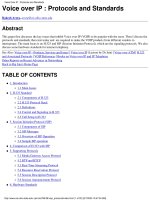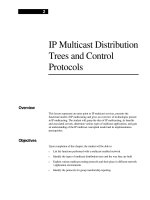IP Signaling Protocols - H.323
Bạn đang xem bản rút gọn của tài liệu. Xem và tải ngay bản đầy đủ của tài liệu tại đây (470.41 KB, 16 trang )
Part III: IP Signaling Protocols
Chapter 10 H.323
Chapter 11
Session Initiation Protocol
Chapter 12
Gateway Control Protocols
Chapter 13
Virtual Switch Controller
Chapter 10. H.323
H.323 is an International Telecommunication Union Telecommunication Standardization Sector (ITU-T)
specification for transmitting audio, video, and data across an Internet Protocol (IP) network, including the
Internet. When compliant with H.323, vendors' products and applications can communicate and interoperate
with each other. The H.323 standard addresses call signaling and control, multimedia transport and control,
and bandwidth control for point-to-point and multipoint conferences. The H series of recommendations also
specifies H.320 for Integrated Services Digital Network (ISDN) and H.324 for plain old telephone service
(POTS) as transport mechanisms.
The H.323 standard consists of the following components and protocols:
The H.323 system is discussed in the following three sections:
• H.323 elements
• H.323 protocol suite
H.323 Elements
Figure 10-1 illustrates the elements of an H.323 system. These elements include terminals, gateways,
gatekeepers, and multipoint control units (MCU).
Feature Protocol
Call Signaling H.225
Media Control H.245
Audio Codecs G.711, G.722, G.723, G.728, G.729
Video Codecs H.261, H.263
Data Sharing T.120
Media Transport RTP/RTCP
• H.323 call-flows
164
Figure 10-1. Elements of H.323 Networking
Often referred to as endpoints, terminals provide point-to-point and multipoint conferencing for audio and,
optionally, video and data. Gateways interconnect to Public Switched Telephone Network (PSTN) or ISDN
networks for H.323 endpoint interworking. Gatekeepers provide admission control and address translation
services for terminals or gateways. MCUs are devices that allow two or more terminals or gateways to
conference with either audio and/or video sessions.
Terminal
The network element illustrated in Figure 10-2 is defined in H.323 as a terminal. H.323 terminals must have a
system control unit, media transmission, audio codec, and packet-based network interface. Optional
requirements include a video codec and user data applications.
165
Figure 10-2. Relationships of H.323 Components
• System Control Unit—Provides H.225 and H.245 call control, capability exchange, messaging, and
signaling of commands for proper operation of the terminal.
• Media Transmission—Formats the transmitted audio, video, data, control streams, and messages onto
network interface. Media transmission also receives the audio, video, data, control streams, and
messages from the network interface.
• Audio Codec—Encodes the signal from the audio equipment for transmission and decodes the
incoming audio code. Required functions include encoding and decoding G.711 speech and
transmitting and receiving a-law and µ-law formats. Optionally, G.722, G.723.1, G.728, and G.729
encoding and decoding can be supported.
• Video Codec—Optional, but if provided, must be capable of encoding and decoding video according to
H.261 Quarter Comment Intermediate Format (QCIF).
• Data Channel—Supports applications such as database access, file transfer, and audiographics
conferencing (the capability to modify a common image over multiple users' computers
simultaneously), as specified in Recommendation T.120.
Gateway
Gateways are not needed unless interconnection with the SCN is required. Therefore, H.323 endpoints can
communicate directly over the packet network without connecting to a gateway. The gateway acts as an H.323
terminal or MCU on the network and an SCN terminal or MCU on the SCN, as illustrated in Figure 10-3
.
The following functions and capabilities are within the scope of the H.323 terminal:
• Network Interface—A packet-based interface capable of end-to-end Transmission Control Protocol
(TCP) and User Datagram Protocol (UDP) unicast and multicast services.
The H.323 gateway reflects the characteristics of a Switched Circuit Network (SCN) endpoint and H.323
endpoint. It translates between audio, video, and data transmission formats as well as communication systems
and protocols. This includes call setup and teardown on both the IP network and SCN.
166
Figure 10-3. Elements of an H.323 Gateway
Gatekeeper
New versions of H.323—such as H.323 version 3, which was scheduled to be finalized on paper by the end of
1999—will attempt to recommend a gatekeeper inter-communication specification. The Gatekeeper can use a
simple query/response sequence (Location Request [LRQ] or Location Confirmation [LCF]) to remotely locate
users. To exchange some information, H.323 version 3 also uses Annex G for database query or exchange.
Yet another protocol, the Open Settlements Protocol (OSP), also specified as European Telecommunication
Standards Institute (ETSI) TS 101 321, is used largely for intra-domain interactions from both the gateway and
gatekeepers.
If a gatekeeper is present in an H.323 system, it must perform the following:
• Address Translation—Provides endpoint IP addresses from H.323 aliases (such as
)
or E.164 addresses (standard phone numbers).
• Admissions Control—Provides authorized access to H.323 using the Admission Request/Admission
Confirm/Admission Reject (ARQ/ACF/ARJ) messages, discussed in the "RAS Signaling" section later
in this chapter.
• Bandwidth Control—Consists of managing endpoint bandwidth requirements using Bandwidth
Request/Bandwidth Confirm/Bandwidth Reject (BRQ/BCF/BRJ) messages, discussed in the "RAS
Signaling" section later in this chapter.
Optionally, the gatekeeper can provide the following functionality:
• Call Control Signaling—Uses the Gatekeeper Routed Call Signaling (GKRCS) model, reviewed in the
"Call Control Signaling (H.225)" section later in this chapter.
• Call Authorization—Enables the gatekeeper to restrict access to certain terminals and gateways or to
restrict access based on time-of-day policies.
• Call Management—Services include maintaining an active call list that you can use to indicate that an
endpoint is busy.
An optional function, the gatekeeper provides pre-call and call-level control services to H.323 endpoints.
Gatekeepers are logically separated from the other network elements in H.323 environments. If more than one
gatekeeper is implemented, inter-communication is accomplished in an unspecified manner.
• Zone Management—Provided for registered terminals, gateways, and MCUs and discussed further in
the "RAS Signaling" section later in this chapter.
• Bandwidth Management—Enables the gatekeeper to reject admission if the required bandwidth is not
available.
167
The MCU and Elements
The multipoint processor (MP) receives audio, video, and/or data streams and distributes them to endpoints
participating in a multipoint conference.
The MCU is an endpoint that supports multipoint conferences and, at a minimum, consists of an MC and one
or more MPs. If it supports centralized multipoint conferences, a typical MCU consists of an MC and an audio,
video, and data MP.
H.323 Proxy Server
• Terminals that don't support Resource Reservation Protocol (RSVP) can connect through access or
local-area networks (LANs) with relatively good quality of service (QoS) to the proxy. Pairs of proxies
can then negotiate adequate QoSs to tunnel across the IP network. Proxies can manage QoS with
RSVP and/or IP precedence bits.
• Proxies support the routing of H.323 traffic separate from ordinary data traffic through application-
specific routing (ASR).
• A proxy is compatible with network address translation, enabling H.323 nodes to be deployed in
networks with private address space.
H.323 Protocol Suite
The H.323 protocol suite is based on several protocols, as illustrated in Figure 10-4. The protocol family
supports call admissions, setup, status, teardown, media streams, and messages in H.323 systems. These
protocols are supported by both reliable and unreliable packet delivery mechanisms over data networks.
Figure 10-4. Layers of the H.323 Protocol Suite
The multipoint controller (MC) supports conferences between three or more endpoints in a multipoint
conference. MCs transmit the capability set to each endpoint in the multipoint conference and can revise
capabilities during the conference. The MC function can be resident in a terminal, gateway, gatekeeper, or
MCU.
An H.323 proxy server is a proxy specifically designed for the H.323 protocol. The proxy operates at the
application layer and can examine packets between two communicating applications. Proxies can determine
the destination of a call and perform the connection if desired. The proxy supports the following key functions:
• A proxy deployed without a firewall or independently of a firewall provides security so that only H.323
traffic passes through it. A proxy deployed in conjunction with a firewall enables the firewall to be
simply configured to pass all H.323 traffic by treating the proxy as a trusted node. This enables the
firewall to provide data networking security and the proxy to provide H.323 security.
168
Although most H.323 implementations today utilize TCP as the transport mechanism for signaling, H.323
version 2 does enable basic UDP transport. Also, other standards bodies are investigating the use of other
reliable UDP mechanisms to create more scalable signaling methods.
• Registration, Admissions, and Status (RAS) Signaling—Provides pre-call control in H.323 gatekeeper-
based networks.
• Call Control Signaling—Used to connect, maintain, and disconnect calls between endpoints.
• Media Control and Transport—Provides the reliable H.245 channel that carries media control
messages. The transport occurs with an unreliable UDP stream.
RAS Signaling
RAS signaling provides pre-call control in H.323 networks where gatekeepers and a zone exist. The RAS
channel is established between endpoints and gatekeepers across an IP network. The RAS channel is opened
before any other channels are established and is independent of the call control signaling and media transport
channels. This unreliable UDP connection carries the RAS messages that perform registration, admissions,
bandwidth changes, status, and disengage procedures.
Gatekeeper Discovery
Auto discovery enables an endpoint, which might not know its gatekeeper, to discover its gatekeeper through a
multicast message. Because endpoints do not have to be statically configured or reconfigured for gatekeepers,
this method has less administrative overhead. The gatekeeper discovery multicast address is 224.0.1.41, the
gatekeeper UDP discovery port is 1718, and the gatekeeper UDP registration and status port is 1719. The
following three RAS messages are used for H.323 gatekeeper auto discovery:
The H.323 protocol suite is split into three main areas of control:
The remainder of this section focuses on these three key signaling functions.
Gatekeeper discovery is a manual or automatic process endpoints use to identify which gatekeeper to register
with. In the manual method, endpoints are configured with the gate-keeper's IP address and, therefore, can
attempt registration immediately, but only with the predefined gatekeeper. The automatic method enables the
relationship between endpoints and gatekeepers to change over time and requires a mechanism known as
auto discovery.
• Gatekeeper Request (GRQ)—A multicast message sent by an endpoint looking for the gatekeeper.
Figure 10-5
illustrates the messaging and sequencing processes for auto discovery.
• Gatekeeper Confirm (GCF)—The reply to an endpoint GRQ indicating the transport address of the
gatekeeper's RAS channel.
• Gatekeeper Reject (GRJ)—Advises the endpoint that the gatekeeper does not want to accept its
registration. This is usually due to a configuration on the gateway or gatekeeper.
169









